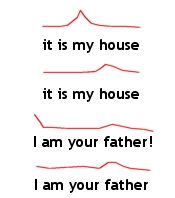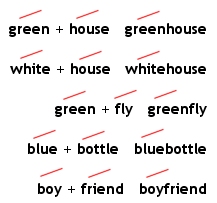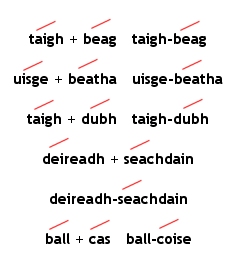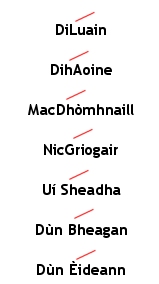An diofar eadar na mùthaidhean a rinneadh air "Stress placement and Why going up is a bad thing"
| Loidhne 1: | Loidhne 1: | ||
| − | One of the more elusive things to watch out for - stress. Thankfully, it's not going to be stressful as it is | + | One of the more elusive things to watch out for - stress. Thankfully, it's not going to be stressful as it is |
| + | ''relatively'' straightforward. | ||
You ever watched an Australian soap? Notice anything odd (or even annoying) about the way some of them talk? Brownie points - the sentence stress patterns of Australian English have shifted (even if you wouldn't have put it quite that way.) | You ever watched an Australian soap? Notice anything odd (or even annoying) about the way some of them talk? Brownie points - the sentence stress patterns of Australian English have shifted (even if you wouldn't have put it quite that way.) | ||
Mùthadh on 07:37, 6 dhen Lùnastal 2013
One of the more elusive things to watch out for - stress. Thankfully, it's not going to be stressful as it is relatively straightforward.
You ever watched an Australian soap? Notice anything odd (or even annoying) about the way some of them talk? Brownie points - the sentence stress patterns of Australian English have shifted (even if you wouldn't have put it quite that way.)
Most Western European languages have something in common - well, vaguely in common. Most have vaguely similar stress patterns for making a declarative sentence (i.e. you state something) and another pattern for marking a question. Before you crucify me for this gross generalisation, this statement about European languages is purely illustrative - of course they all differ when you look at the details.
Let's look at some examples:
Now, I don't want to go into the details of English, but the important thing to take from this diagram is that in English, a declarative sentence has a few humps and bumps for word stress, but on the whole is relatively level. In a question, there is a decided rise at the end of the sentence.
German, even though the details are different, does something very similar to questions:
Mostly level for a statement and a rise at the end for a question. It's so common some people call it the Indo-European question intonation ...
Not surprisingly (otherwise there wouldn't be a page for it here) Gaelic does things differently, even though it's Indo-European.
Gaelic, on the whole, maintains a steady fall in statements and questions. Here's a few examples before we launch into the why and how:
So what's going on here? Allowing for humps and bumps to do with word stress, there is a clear fall. Even though there is a bump for the final noun/adjective which receives primary word stress, the overall fall (compared to the starting point) is clearly maintained.
Why? Think of it. Gaelic has an elaborate system of making statements and questions: you have a way of clearly telling the listener right from the start that you are about to make a statement e.g. tha mi..., a question e.g. a bheil mi...?, a negative question e.g. nach eil mi...? or a negative statement e.g. chan eil mi... So there is no room for confusion right from the start.
In English you can signal a question by moving around parts of your sentence e.g. there is a dog at the door vs is there a dog at the door, but for whatever reason English and most other European languages developed this question-rise. Australian English sounds so odd to British English speakers because it has started using the question intonation pattern for making declarative statements ... !
Gaelic on the whole uses stress less to emphasise things - think of it. We have all those handy emphatic forms and suffixes to signal stress, so adding word stress is really superfluous - and since we're lazy, we don't do it.
English only has the one set of pronouns for example: I, you, he, she etc ... so if you want to stress that *you* saw something, you have to employ word stress.
But in Gaelic you even have two ways of signalling that: you can either use an emphatic pronoun mise, thusa etc or you can additionally focus the pronoun by fronting it: 's e mise a rinn e!
Here are a few contrasting examples:

|

|
In either Gaelic sentence, the overall stress pattern is more or less the same - the difference in meaning being encoded in the structure. English on the other hand, which has not such structures, uses stress the signal the difference in meaning.
So the first thing to learn here is NOT to go up with your voice in Gaelic for making a question or a statement - maintain an overall fall.
The second thing? Well, generally speaking the same thing applies to word stress. In English, stress is pretty unpredictable, it can show up anywhere, think of minimal pairs like pérmit vs permít, ádditive vs addítion or simply the chaos the clash of Norman French stress patterns and Anglo-Saxon ones has left behind: húsband vs disbánd, máshing vs machíne and so on. It's a mess.
Gaelic is lucky in that respect as it has preserved it's native stress patterns rigorously: stress on the first syllable, everything else is unstressed. This is, incidentally, the reason why Gaelic vowels which aren't in the first syllable are often reduced to schwa's (unclear vowels) - all the stress energy has gone into the first syllable, the rest has to make do with what is left. A few examples:

|
The last one is a very illustrative example. Although cuimhne has a clear vowel [kɯiNʲə], this is reduced to a schwa in dìochuimhneachadh because it is no longer in a stressed syllable: [dʲiəxəɲəxəɣ].
But what is life without exceptions? Don't worry, there are not many, mostly these two: tombaca and buntàta, which have stress on the second syllable.
The last thing isn't really en exception, more like an additional rule: sometimes two words come together the form a new compound. In this instance, both English and Gaelic do more or less the same thing: of the two primary stresses that were initially present, only one survives. Let's look at some English examples first:

|
In all these cases there is a shift in meaning by the way - a blue bottle you might put in your display cabinet, but would you do the same with a bluebottle?
Now to Gaelic:

|
You have the genitive to contend with, but that aside the process is very similar to English. And this is where two important rules come in which are often misunderstood:
A hyphen is used between two words (noun + noun, noun + adjective etc) when only one of the two elements carries primary stress. This means that they have formed a so called close compound. So listen for the stress carefully. It can occur on either element, the first or the second. If it occurs on the second and the words are compatible in terms of the broad/slender letters, they may be written as one (prefixes often had two forms to accommodate for this): dìochuimhne, mairtfheoil, oilthigh...
If the close compound consists of two nouns and stress is on the second element, the second element is treated as if it were an adjective and is thus lenited after feminine nouns etc. For examples: bileag-fhiosrachaidh, cais-bheairt (cas + beairt), bó-bhainne...
In very few instances a different method is employed in the orthography to show forward stress by spelling them together with a capital letter in the middle. This applies to the days of the week, surnames and place names (which are spelt without hyphen but with two capital letters):

|
So the capital letter that GOC so nonchalantly abolishes actually serves quite an important function ... as so many things GOC does away with.
Happy stressing!
| Beagan gràmair | ||||||||||||
| ᚛ Pronunciation - Phonetics - Phonology - Morphology - Tense - Syntax - Corpus - Registers - Dialects - History - Terms and abbreviations ᚜ | ||||||||||||